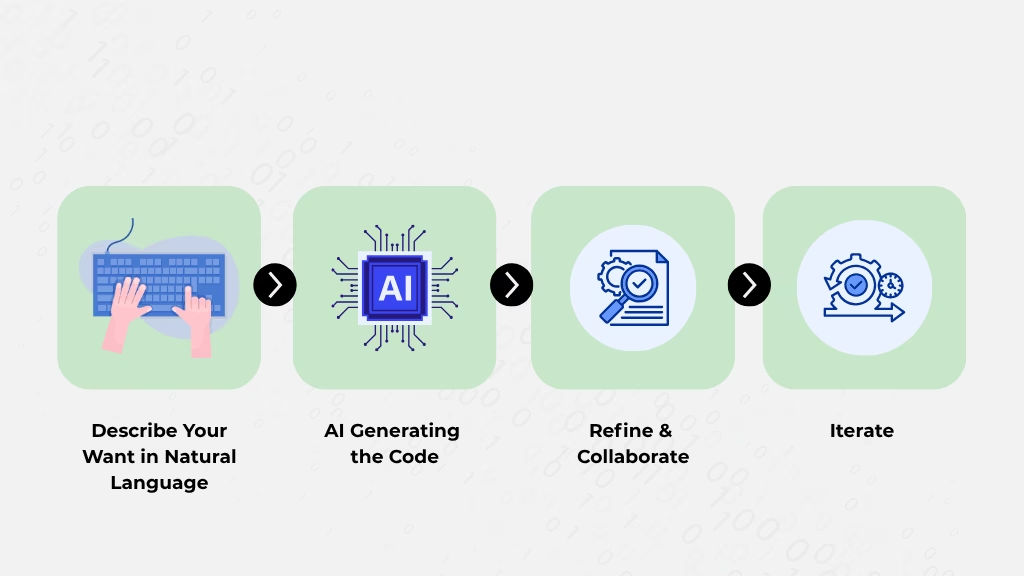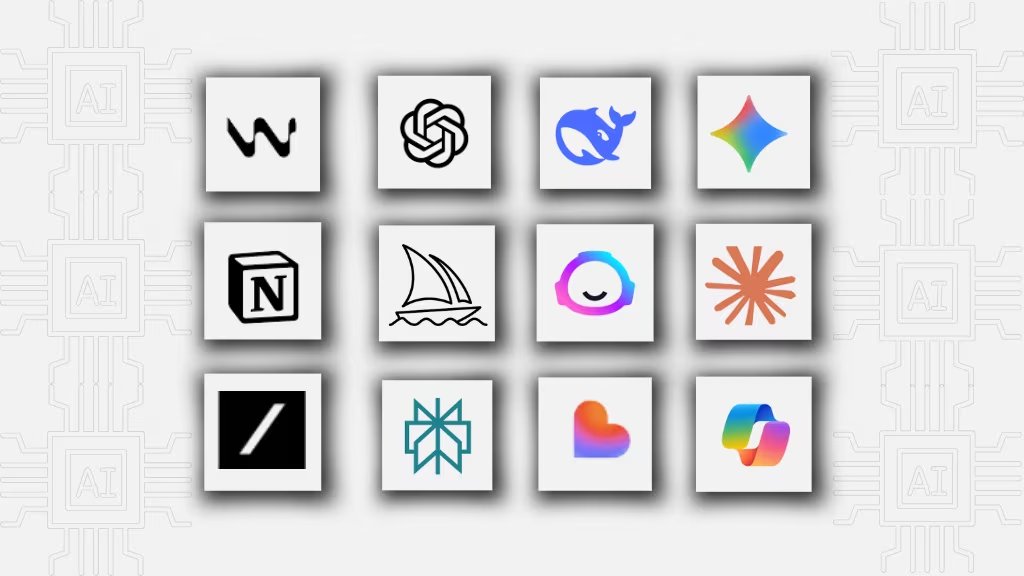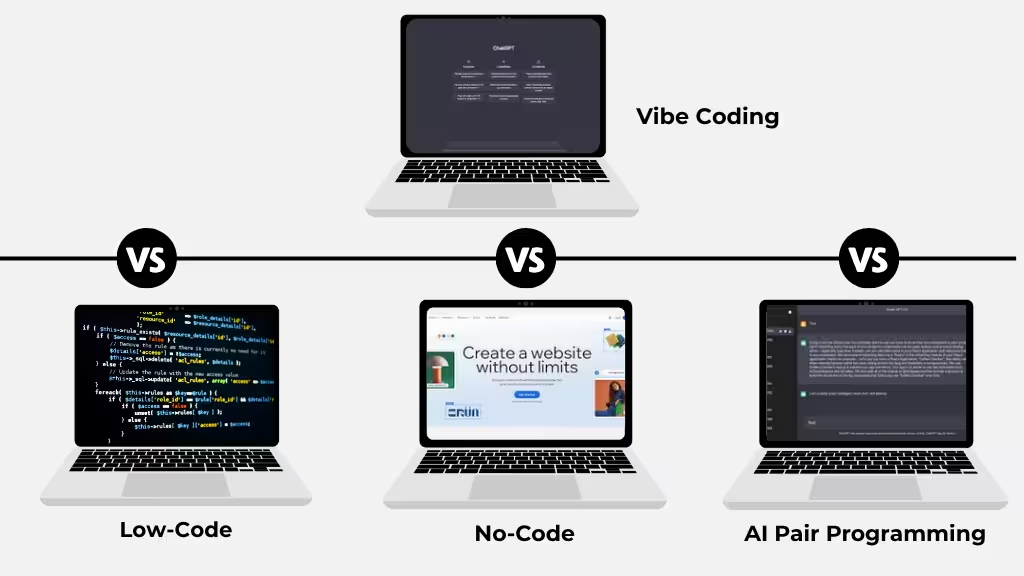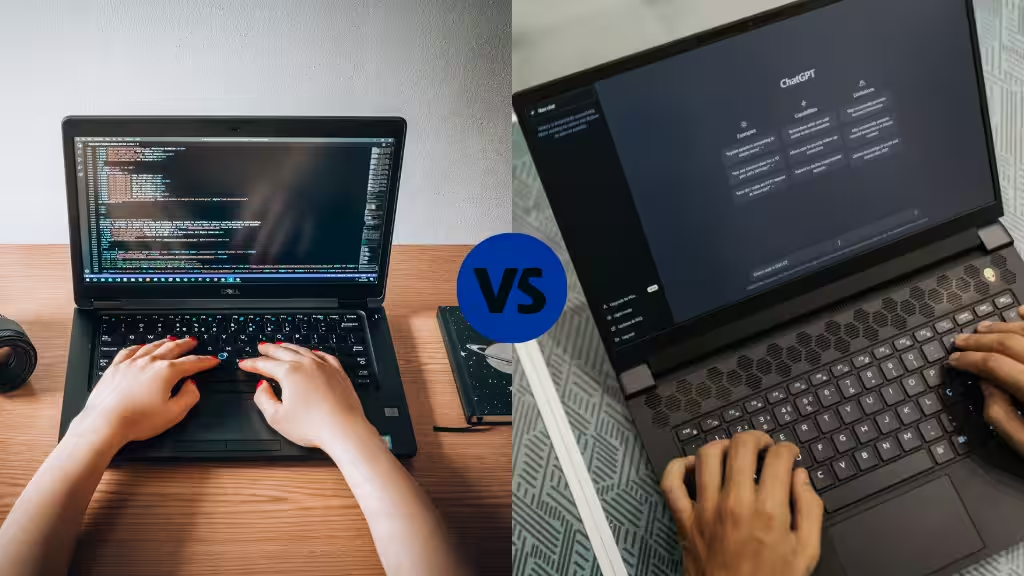- How Did Coding Evolve from Syntax to Natural Language Programming
- How Does Vibe Coding Work? Step by Step Breakdown
- What Are the Use Cases of Vibe Coding
- Why Vibe Coding Matters for Modern Developers
- What Are the Best Tools and Platforms for Vibe Coding
- What Makes Vibe Coding Different from Low-Code, No-Code, and AI Pair Programming
- What Are the Key Benefits of Vibe Coding
- What Are the Technical Challenges and Limitations of Vibe Coding
- What is the Vibe Coding Prompt Template Kit
- What Is the Difference Between Traditional Coding and Vibe Coding
- Is Vibe Coding the Future
- Conclusion
- Frequently Asked Questions (FAQs)
Ever wished you could just tell your computer what to build, instead of spending hours typing code? You’ll love what’s next.
Vibe Coding is an AI-powered approach to software development that lets you describe your app in natural language, and get working code in minutes. Instead of traditional coding, vibe coding lets you describe what you want in simple, natural language, and the AI instantly generates the functional code for you.
Sounds incredible, right? It’s coding that feels effortless, no syntax errors, no complex logic trees. Just clear ideas, expressed in your own words, turned into working apps within minutes. Whether you’re an experienced developer or someone with no coding background, vibe coding opens the door for anyone to build.
In this guide, you’ll learn what Vibe Coding is, how it works, the best tools, prompt templates, and why it’s reshaping the future of programming.
How Did Coding Evolve from Syntax to Natural Language Programming?
The term Vibe Coding was introduced by Andrej Karpathy, a renowned computer scientist and former Director of AI at Tesla, in February 2025. In a tweet, Karpathy described it as “a new kind of coding where you fully give in to the vibes, embrace exponentials, and forget that the code even exists.”
Karpathy’s concept wasn’t about replacing programmers, but about elevating their creative role. With Vibe Coding, humans act more like directors or architects, setting the vision, defining the outcome, and guiding AI through conversational collaboration.
This shift marked a turning point in how we think about software creation. But what does Vibe Coding truly mean, and how does it transform the way we build and create?
What Is Vibe Coding
Vibe Coding is a new approach to creating software where creators use natural language to communicate with artificial intelligence models that generate functional code or complete applications. Instead of manually programming with syntax and commands, developers express their intent in plain language, and the AI interprets it into executable results.
Why it is getting popular:
- Anyone can build apps, even without coding skills
- AI handles the hard work, saving time and effort
- Encourages creativity and experimentation
- Offers an immersive coding experience that feels natural
Now that you understand what Vibe Coding is and why it’s capturing so much attention, let’s take a closer look at how it actually works, step by step.
How Does Vibe Coding Work? Step by Step Breakdown

To truly unlock the magic of Vibe Coding, you don’t just need an AI assistant.
You need the right environment, a clear vision, and a workflow that sparks creativity.
Follow this simple, beginner-friendly breakdown to go from an idea in your head to a live application that reflects your vibe.
Step 1: Describe Your Vision in Natural Language
Every vibe coding project starts with an idea.
Instead of writing syntax-heavy code, you simply explain your goal in everyday language.
Example Prompt:
“Build a meditation timer app that feels calm and minimal. Use soft gradients, rounded buttons, and a relaxing tone throughout the interface.”
Here, your vibe (the emotional tone) becomes part of the development blueprint.
The AI interprets your intent and begins to shape a framework, usually in JavaScript, React, or Python, depending on your platform.
Why it matters: This step bridges imagination and code, allowing anyone, even non-developers, to create functional software.
Step 2: Let the AI Generate Your Foundation
Once your idea is clear, your AI coding assistant (like ChatGPT, Claude Code, or GitHub Copilot) generates the base code, setting up the layout, UI components, and basic functionality.
This stage is all about turning your words into working structure, the AI handles logic, while you focus on creativity.
Example Prompt:
“Create a responsive recipe app with a clean design. Display recipes in card format, with pastel tones and smooth hover animations.”
Why it works: You’re giving both the function (what it does) and the feeling (how it looks and behaves).
Step 3: Refine Through Human–AI Collaboration
Here’s where vibe coding truly shines. You can chat with your AI to improve what it built, refining colors, layout, animations, or interactivity.
It’s like having a design partner who instantly tests your ideas.
Example Refinement Prompts:
1. “Add a soft fade-in effect for all images.”
2. “Make the buttons slightly larger and add a glowing hover animation.”
3. “Give the homepage a more energetic look with brighter tones.”
Transition Tip: Each iteration brings you closer to your desired emotion and flow, blending AI-assisted coding with your human intuition.
Step 4: Test, Polish, and Perfect the Vibe
After refining, test how your app feels in action. This step goes beyond functionality, it’s about emotional impact.
Ask yourself:
- Does the design match the energy I wanted to create?
- Is it easy to use and visually balanced?
- Does the interaction feel natural and expressive?
Example Prompt:
“Optimize this app for mobile. Keep the calm color palette, but make animations faster and smoother for a snappier user experience.”
Result: You now have a polished product that’s functional, aesthetic, and emotionally consistent, the essence of creative coding.
Step 5: Launch and Share Your Creation
Finally, bring your vibe-coded app to life! Deploy it using platforms like Replit, Vercel, or Lovable, and share it with your audience.
Example Prompt:
“Prepare this React app for deployment on Vercel, and add a simple landing page with my brand’s pastel theme and tagline.”
Why it matters: The final step connects your vision with real-world users, showing how AI-powered development makes creativity more accessible than ever.
You’ve seen the process, from idea to launch. But where does vibe coding actually shine in practice? Let’s explore some real-world use cases that show how creators and developers are using it to build smarter, faster, and more creatively.
What Are the Use Cases of Vibe Coding
As Vibe Coding evolves, it’s quickly finding applications across industries, from startups and enterprises to classrooms and creative studios. Its ability to turn natural language prompts into working code makes it ideal for rapid prototyping, experimentation, and innovation.
Here’s how different groups are using vibe-based development in practice, along with example prompts you can try yourself.
1. Startups Using Vibe Coding for Rapid Prototyping
Startups love Vibe Coding because it helps them go from idea to product in record time. Instead of hiring large teams or spending months coding, founders can describe what they want and generate functional prototypes in hours.
Use Case Example:
A startup founder wants to test a new wellness app concept before investing in full development.
Prompt Example:
“Create a simple mindfulness app with a daily mood tracker and short guided meditation sessions. Use a soft color palette, minimalist layout, and include a progress dashboard.”
Outcome:
Within minutes, the AI produces a working prototype that can be shared with early testers, reducing cost and accelerating validation.
2. Enterprises Accelerating Digital Transformation
For enterprises, Vibe Coding supports automation and modernization. Teams can use it to rapidly generate internal tools, automate workflows, or prototype digital products that integrate with existing systems.
Use Case Example:
A retail company wants to automate inventory tracking and report generation.
Prompt Example:
“Build a web-based dashboard that displays real-time inventory data from an Excel or Google Sheets file. Include stock alerts, visual charts, and a summary of top-selling items.”
Outcome:
The AI generates a dashboard framework that teams can refine and deploy internally, cutting development cycles from months to days.
3. Individual Creators and Indie Developers
For solo creators, vibe programming offers freedom to build passion projects without heavy technical barriers. It’s ideal for creative coding sessions and experimentation, where imagination drives the outcome.
Use Case Example:
An indie game developer wants to design an interactive art piece that reacts to music.
Prompt Example:
“Generate a web-based music visualizer that animates colorful waves and particles in sync with audio beats. Use JavaScript and include a mood-based color theme selector.”
Outcome:
The result is an immersive coding experience where ideas evolve naturally through play and iteration.
4. Education and Learning Environments
Educators are using Vibe Coding to make programming more approachable for students. By replacing syntax with natural conversation, learners can focus on logic, problem-solving, and creativity rather than memorizing code structures.
Use Case Example:
A teacher wants students to learn data visualization concepts in a fun, interactive way.
Prompt Example:
“Create an interactive chart that visualizes climate change data over time. Include buttons to switch between temperature, CO₂ levels, and sea-level data, and display a short explanation beside each chart.”
Outcome:
Students gain a hands-on understanding of coding logic and design, without getting lost in syntax, making the learning process more intuitive and engaging.
These real-world examples make one thing clear, vibe coding isn’t just a trend; it’s a shift in how modern developers think, create, and collaborate.
Let’s explore why this new approach matters so much in today’s fast-evolving development landscape.
Why Vibe Coding Matters for Modern Developers
Coding isn’t just about writing functions anymore, it’s about creating experiences that resonate. That’s exactly where Vibe Coding steps in.
Think of Vibe Coding as the bridge between technical precision and creative flow. It’s not just about syntax or frameworks; it’s about feeling the rhythm of your code so that building features becomes more natural, and efficient.
The Modern Developer’s Edge
Modern developers juggle more than ever: shifting tech stacks, evolving user expectations, and tight deadlines. Vibe Coding helps you stay ahead by:
- Enhancing Focus & Flow: When you tap into the “vibe,” coding feels less like a chore and more like a creative process.
- Boosting Collaboration: A shared coding vibe across teams makes communication smoother and accelerates development cycles.
- Improving Problem-Solving: Staying in the zone helps you think clearly and approach challenges with fresh perspectives.
- Reducing Burnout: Aligning your workflow with your natural rhythm can make long coding sessions less draining.
Now that you understand why Vibe Coding is transforming the way modern developers work, let’s explore the tools and platforms that make this creative, AI-powered workflow possible.
What Are the Best Tools and Platforms for Vibe Coding

Honestly, the rise of Vibe Coding wouldn’t be possible without a new generation of AI-powered development tools. These platforms bridge the gap between human creativity and machine intelligence, turning natural language app development prompts into functional, elegant code.
Whether you’re a professional developer or someone exploring vibe-based development for the first time, these tools make it easy to experience that immersive coding flow where ideas turn into software effortlessly.
1. ChatGPT – The Conversational Coder
Best for: Rapid prototyping, ideation, and creative coding sessions
- ChatGPT allows you to describe what you want in plain language, and it instantly generates working code snippets, explanations, or full applications.
- Great for brainstorming, learning, and testing new ideas in real time.
- Perfect for beginners who want to understand code, not just produce it.
Example use: “Build a responsive portfolio website with a calming dark mode theme and smooth transitions.”
2. GitHub Copilot – Your AI Pair Programmer
Best for: Professional developers and ongoing projects
- Integrated directly into IDEs like VS Code, Copilot predicts and completes code as you type.
- Ideal for maintaining a coding flow state, no switching tabs or searching for syntax.
- Offers real-time suggestions that make vibe programming seamless within complex projects.
Tip: Great for experienced coders who want AI to accelerate, not replace, their workflow.
3. Replit – The All-in-One Creative Playground
Best for: Experimentation and collaborative coding
- Replit combines AI assistance with a live coding environment, making it perfect for creative coding sessions.
- You can build, run, and deploy apps right in your browser, no setup needed.
- Great for learners, startups, or anyone who loves instant feedback and collaboration.
Example use: “Generate an interactive weather app that visualizes temperature changes with animated backgrounds.”
4. Claude Code – The Contextual Collaborator
Best for: Deep reasoning and large codebases
Claude by Anthropic handles complex instructions and multi-file reasoning effortlessly.
- Great for refactoring, documenting, and analyzing architecture.
- Understands natural language prompts with contextual nuance.
Example use: “Clean up my backend logic and optimize for better API response times.”
5. Lovable – The AI App Builder for Everyone
Best for: No-code to low-code app creation
Lovable converts plain English descriptions into deployable web apps.
- Perfect for founders, creators, and small teams.
- Includes built-in design, deployment, and hosting features.
Example use: “Create a budget tracker app with visual charts and cloud sync.”
6. Windsurf – The Seamless AI IDE
Best for: Integrated AI coding and real-time debugging
Windsurf blends a modern IDE with conversational AI.
- Write and fix code collaboratively with instant context awareness.
- Excellent for debugging and improving existing projects.
Example use: “Analyze this codebase for performance bottlenecks and fix them.”
7. DeepSeek – The Reasoning Powerhouse
Best for: Complex logic, code optimization, and multi-step reasoning
DeepSeek is an advanced open-source AI designed for deep technical problem-solving.
- Excellent for algorithmic challenges, debugging, and architecture design.
Example use: “Optimize this neural network training loop for speed and memory efficiency.”
8. Midjourney – The Visual Coder’s Muse
Best for: Visual and UI prototyping
Midjourney generates stunning UI concepts, logos, and app visuals from text prompts.
- Perfect for front-end designers or vibe coders who visualize before building.
Example use: “Design a sleek mobile dashboard for a habit tracker app with a calming aesthetic.”
9. Grok (by xAI) – The Conversational Reasoner
Best for: Intelligent exploration and playful coding
Grok blends humor, reasoning, and creativity, ideal for brainstorming and experimental coding.
- Great for generating unconventional solutions or quick technical insights.
Example use: “Help me write a witty, functional Python script that tweets random coding tips.”
10. Perplexity – The Research and Knowledge Engine
Best for: Research, exploration, and real-time data-driven coding
Perplexity blends conversational search with factual grounding, helping vibe coders make informed technical decisions.
- Perfect for researching APIs, frameworks, and implementation patterns before coding.
Example use: “Find the best JavaScript libraries for AI-driven chart generation with examples.”
Now that you’ve seen the tools powering this new creative movement, it’s worth asking, how does vibe coding actually differ from other modern development styles like low-code, no-code, or AI pair programming?
What Makes Vibe Coding Different from Low-Code, No-Code, and AI Pair Programming?

When you first hear about Vibe Coding, it might sound similar to low-code, no-code, or AI pair programming, but the truth is, it’s an evolution of all three.
Let’s break down how vibe coding compares to these approaches and why it’s quickly becoming the next creative leap in software development.
Vibe Coding vs. Low-Code Platforms
Low-code tools like Mendix or OutSystems simplify development by using drag-and-drop interfaces and pre-built components.
They’re great for speeding up enterprise app delivery, but they still require some technical understanding.
Here’s where vibe coding shifts the game:
- Instead of relying on a visual interface, you use natural language to describe exactly what you want.
- The AI interprets your intent and writes the functional code behind the scenes.
- It feels less like configuring a template and more like collaborating with a creative partner who understands your idea.
In short: Low-code simplifies how you build; vibe coding reimagines who builds and why.
Vibe Coding vs. No-Code Development
No-code platforms like Bubble, Webflow, or Glide aim to make app creation accessible to anyone, no coding required.
However, they often limit creativity within predefined design or logic structures.
Vibe coding removes those limits by:
- Letting you express your idea in your own words, not within rigid templates.
- Producing real, editable code that can evolve beyond platform boundaries.
- Allowing a more personalized, emotional touch, where your design’s “vibe” truly reflects your imagination.
Think of no-code as painting by numbers, while vibe coding is painting with your thoughts.
Vibe Coding vs. AI Pair Programming
AI pair programming tools like GitHub Copilot or Amazon CodeWhisperer assist developers as they write code, suggesting completions or functions.
They enhance productivity but still depend on a coder’s understanding of syntax and structure.
Vibe coding goes a step further:
- You start from ideas, not code.
- The AI takes on the heavy lifting, generating, explaining, and refining entire workflows.
- You act as a creative director, shaping the outcome through conversation and iteration.
In vibe coding, you don’t just code faster, you code more intuitively.
Why Vibe Coding Is the Next Step
Vibe coding blends the freedom of no-code, the power of low-code, and the collaboration of AI pair programming, all through the simplicity of natural language.
It’s not about removing humans from development; it’s about amplifying human creativity through AI.
Whether you’re a professional developer or a curious creator, vibe coding makes building digital experiences feel effortless, expressive, and deeply personal.
After comparing vibe coding to low-code, no-code, and AI pair programming, one thing is clear, vibe coding brings something unique to the table.
Let’s take a closer look at the key benefits that make it such a game-changer for developers and creative thinkers alike.
What Are the Key Benefits of Vibe Coding?
The power of Vibe Coding lies in how it redefines the software creation process. By blending human creativity with AI intelligence, it transforms traditional development into an immersive coding experience that’s faster, more intuitive, and accessible to everyone.
Here are the core benefits that make vibe programming a true game-changer:
- Speed: Build Faster Than Ever
- Accessibility: Coding for Everyone
- Creativity: Focus on Ideas, Not Syntax
- Collaboration: Humans and AI
- Efficiency: Smarter Development, Lower Costs
While the benefits of Vibe Coding are truly transformative, it’s important to recognize that this new approach also comes with its own set of challenges. Understanding these limitations helps creators use the technology more effectively and avoid common pitfalls.
What Are the Technical Challenges and Limitations of Vibe Coding?
While Vibe Coding simplifies the development process and enhances creativity, its implementation in real-world projects still faces several technical and practical challenges. Below are the major limitations developers encounter when working with AI-generated code in vibe-based development.
1. Technical Complexity
Although vibe coding makes app creation feel simple, the underlying AI systems are highly complex. Managing integrations, APIs, and prompt structures often requires advanced understanding of both AI models and traditional programming principles.
2. Code Quality and Performance Issues
AI-generated code can sometimes be inefficient, redundant, or poorly optimized. Developers often need to refactor or fine-tune the output to ensure performance and scalability meet production standards.
3. Debugging Challenges
Since the AI automatically generates much of the code, understanding how or why something broke becomes harder. Tracing errors through machine-generated logic can be time-consuming and unpredictable.
4. Maintenance and Update Complexity
Maintaining or updating an AI-generated application can be difficult, especially if the original prompts or model configurations are lost. This makes long-term sustainability a challenge for teams relying heavily on vibe coding.
5. Security and Vulnerability Risks
Generated code might unintentionally introduce security flaws, especially if the model pulls patterns from insecure or outdated data sources. Without manual review, applications could be exposed to potential exploits.
6. Data Dependency and Model Bias
Vibe coding depends heavily on the data and training of its underlying models. If the dataset contains biases or incomplete information, the generated code may reflect those same issues, leading to unfair or unreliable outcomes.
7. Limited Scalability for Complex Systems
While vibe coding works well for prototypes or small applications, scaling to enterprise-level systems with complex logic, integrations, and performance requirements remains difficult.
8. Ethical and Compliance Concerns
The use of AI-generated code raises ethical questions about authorship, intellectual property, and accountability. Organizations must also ensure compliance with licensing and data privacy regulations.
9. Lack of Standardization
Because vibe coding is still an emerging practice, there are no universal standards or best practices. This makes collaboration, code sharing, and tool compatibility inconsistent across teams and platforms.
Overcoming these limitations starts with better communication between you and the AI. A well-structured prompt can make all the difference, and that’s exactly what the Vibe Coding Prompt Template Kit is designed to help you with.
What is the Vibe Coding Prompt Template Kit?
Mastering Vibe Coding begins with crafting clear, creative, and context-rich prompts.
Below is a ready-to-use collection of prompt templates designed to help you start coding with confidence, whether you’re prototyping, designing, or experimenting in your next vibe-based development session.
1. App & Web Development Prompts
These prompts are perfect for generating real-world applications using natural language.
Example Prompts:
“Build a personal finance tracker app with a clean dashboard showing income, expenses, and savings goals. Use React for the frontend and include simple data visualizations.”
“Create a restaurant landing page with smooth scrolling, elegant typography, and an inviting color palette. Make sure it’s mobile responsive.”
“Develop a to-do list web app where users can set goals and track progress through color-coded categories.”
Pro Tip: Start with general functionality, then refine by adding specific design preferences, frameworks, or performance goals.
2. UI/UX and Visual Design Prompts
Use these prompts to bring visual creativity into your vibe programming process.
Example Prompts:
“Design a minimalist dark-themed dashboard with smooth transitions and rounded elements that create a relaxing interface.”
“Generate a vibrant homepage layout inspired by neon aesthetics, with soft animations and interactive hover effects.”
“Create a login screen that feels personal and welcoming, including soft gradients, micro-interactions, and a clean font.”
Goal: Focus on the feel of the experience, this is what keeps you in a coding flow state and helps the AI capture your intended vibe.
3. Automation & Productivity Prompts
These prompts help automate repetitive tasks or optimize workflows through AI-assisted coding.
Example Prompts:
“Write a Python script that organizes files into folders based on their file type and creation date.”
“Generate a tool that sends automated daily reports via email, pulling data from Google Sheets.”
“Create a chatbot that summarizes text documents and highlights key points automatically.”
Tip: For automation projects, specify the input and output format clearly to ensure accurate results.
4. Creative Coding Prompts
If you’re using Vibe Coding for exploration or art, these prompts are designed to fuel your creative coding sessions.
Example Prompts:
“Build a music visualizer that reacts to beats and frequency, displaying smooth wave animations and color changes.”
“Create an interactive art canvas where mouse movements generate organic patterns and shapes.”
“Develop a digital mood board where users can drag, resize, and remix visual elements to create their own compositions.”
Goal: Focus on expressing emotion, motion, and color, let the AI handle structure while you explore the creative flow.
5. Testing, Debugging, and Optimization Prompts
For refining your AI-generated code and improving performance.
Example Prompts:
“Optimize this JavaScript code for faster page load times without changing functionality.”
“Identify potential bugs in this Python script and explain how to fix them.”
“Refactor this React component to improve maintainability and readability.”
Tip: Use these prompts in collaboration mode with your AI assistant, ask follow-up questions to understand every change and build better technical intuition.
Understanding these challenges helps us see why vibe coding isn’t just another AI tool, it’s a completely new way of coding. So how exactly does it differ from traditional programming?
What is the Difference Between Traditional Coding and Vibe Coding?

As technology evolves, the way we build software is changing too. Traditional coding and Vibe Coding share the same goal, creating functional, reliable software, but the approach, experience, and workflow are completely different. Understanding these differences can help you see why vibe-based development is reshaping the future of programming.
| Aspect | Traditional Coding | Vibe Coding |
|---|---|---|
| Input Method | Manual code written by developer | Natural language prompts interpreted by AI |
| Skill Requirement | High technical expertise | Accessible to all skill levels |
| Development Speed | Slower, logic-based | Faster, intuitive, and creative |
| Collaboration | Human-only | Human + AI partnership |
| User Experience | Analytical and structured | Fluid, conversational, and creative |
| Ideal Use | Complex, large-scale systems | Prototyping, creative projects, idea testing |
So, now that we’ve seen how vibe coding transforms the entire development experience, it’s time to ask the big question, is this the future of programming, or just the beginning of a new creative movement?
Is Vibe Coding the Future?
Yes, but not as a replacement, as an evolution. Vibe Coding represents the next chapter in software development, one that merges logic with creativity, speed with simplicity, and humans with intelligent machines.
It’s the bridge between traditional coding and the intuitive, conversational tools of tomorrow, a future where anyone can code, create, and innovate through pure imagination.
- A Shift from Syntax to Creativity
Vibe Coding replaces rigid syntax with imagination, allowing anyone to focus on what they want to build, not how to code it. It expands traditional development into a more creative and human-centered process.
- Expanding Access to Innovation
Vibe-based development removes technical barriers, enabling entrepreneurs, students, and creators to build and test ideas quickly through natural-language prompts.
- The Future: Co-Creation, Not Automation
Vibe programming doesn’t replace developers, it empowers them. The future lies in co-creation, where humans lead with vision and AI transforms ideas into reality.
Despite these technical and practical challenges, the potential of Vibe Coding continues to shine. As the technology matures, its ability to merge creativity with code signals a profound shift in how we think about software development.
Conclusion
Vibe Coding represents more than just a new way to build software, it’s a creative and technological shift that bridges human imagination with AI intelligence. By transforming natural language into functional code, it removes traditional barriers and redefines what it means to create. From startups and enterprises to educators and independent makers, Vibe Coding empowers everyone to build, innovate, and express ideas faster than ever before.
As AI continues to evolve, this approach will shape the next era of digital creation, one where coding feels intuitive, collaborative, and deeply human.
Key Takeaways
- Vibe Coding turns ideas into software through natural language and AI.
- It prioritizes creativity over syntax, making coding more accessible.
- Ideal for rapid prototyping, experimentation, and learning.
- Encourages human-AI collaboration for smarter development.
- Marks the beginning of a new creative revolution in programming.
Frequently Asked Questions (FAQs)
Got questions about Vibe Coding? You’re not alone. Here are some of the most common questions people ask about this new AI-powered approach to building software, answered simply and clearly to help you understand how it really works.
Is Vibe Coding really a thing?
Ans: Yes. Vibe Coding is a real and growing development trend introduced by computer scientist Andrej Karpathy in 2025. It describes using AI tools like ChatGPT or GitHub Copilot to generate working code from natural language prompts, a practice now used by startups, creators, and even enterprises.
Can non-programmers use Vibe Coding?
Ans: Yes, absolutely. Vibe Coding is designed for everyone, even people with no programming background. By using plain language to guide AI, anyone can build prototypes, websites, or tools without learning syntax or technical frameworks. It lowers the barrier to digital creation and innovation.
What’s the point of Vibe Coding if I still have to pay a developer to fix it?
Ans: Vibe Coding speeds up the early stages of development, idea testing, prototypes, and basic app versions. While complex systems may still need developer refinement, it drastically reduces cost and time. You’re paying for finishing touches, not full builds, making projects faster and more affordable overall.
Will Vibe Coding replace developers?
Ans: No; Vibe Coding won’t replace developers; it will empower them. AI handles repetitive or low-level coding, while humans focus on design, strategy, and creative direction. The future of development is human-AI collaboration, where both strengths combine to produce faster, smarter, and more innovative results.
Can you actually make money Vibe Coding?
Ans: Absolutely. Many creators use Vibe Coding to prototype apps, build tools, or offer fast development services. By combining AI efficiency with creative problem-solving, you can produce digital products, automate workflows, or launch small SaaS projects that generate real revenue with minimal technical overhead.
Is Vibe Coding legal?
Ans: Yes, Vibe Coding is legal, but you should verify the licensing and data policies of your AI tools. Some AI models may draw from public code repositories, so reviewing outputs for copyright compliance and security before deployment is best practice, especially for commercial applications.
Why is there so much hate for Vibe Coding?
Ans: Some developers criticize Vibe Coding because they see it as oversimplifying programming or threatening traditional skills. Others worry about unreliable AI-generated code and job displacement. However, most experts agree it’s not replacing developers, it’s expanding creativity and efficiency when used responsibly alongside human expertise.
What skills do I need for Vibe Coding?
Ans: You don’t need deep programming knowledge to start Vibe Coding. Basic logical thinking, clear communication, and a good understanding of your project goals are enough. As you grow, learning fundamentals of coding structure and prompt engineering helps you guide AI more effectively and produce higher-quality results.
This page was last edited on 9 October 2025, at 6:21 pm
How can we help you?
























